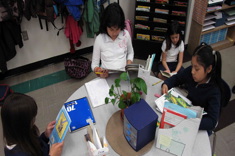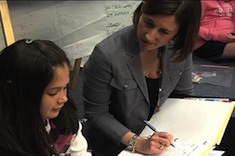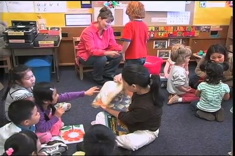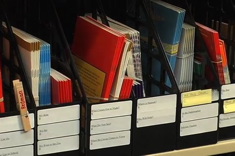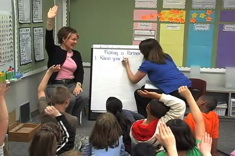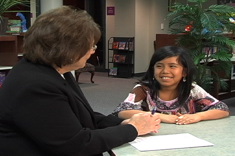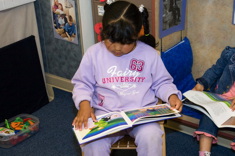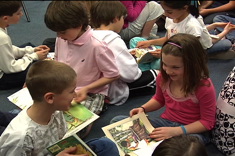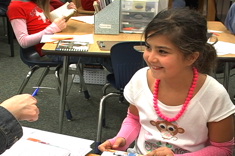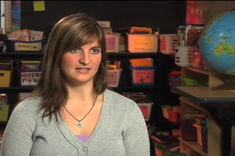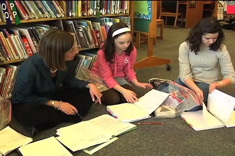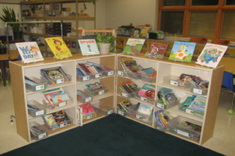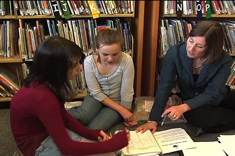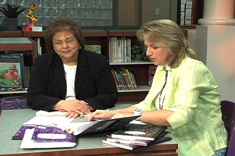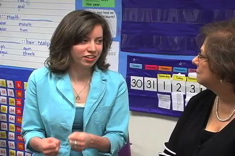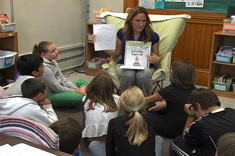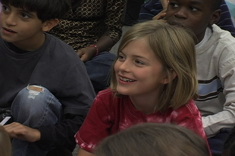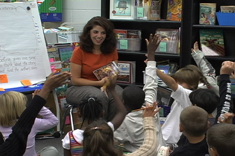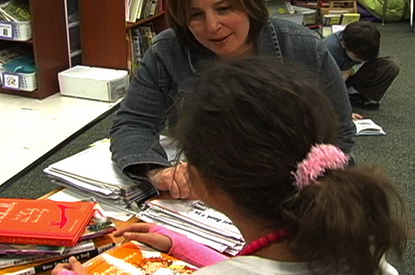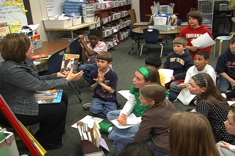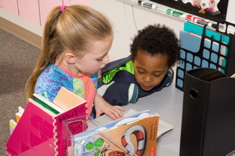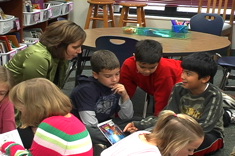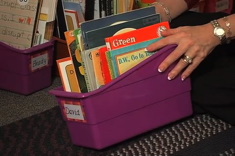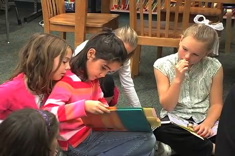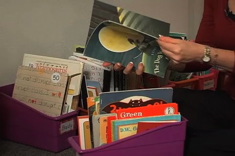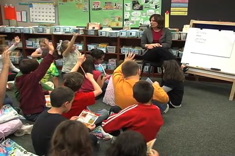Teaching Reading
Our contributors lead reading workshops in classrooms with creative flair. Over the past 12 years, we've filled our site with loads of suggestions, tools, and tips for using engaging books throughout the curriculum to hook kids on reading. Here is where you will find many stories of successful and not-so-successful workshop days, and what we learned from them. We bring these stories to life through hundreds of video examples.
Latest Content
What Are Reading Centers?
Kathy Collins gives a detailed definition of how reading centers are connected to the goals of different reading units of study.
Conferring About Character Traits
In this conference from a fifth-grade classroom, Clare Landrigan meets with a student to reinforce learning from a whole-class lesson on inferring and character traits.
Multicultural Picture Books for Young Children
These books do double duty – building community and understanding of the sounds of language.
Small Group After Demonstration Lesson
In this small group after a demonstration lesson in a 5th grade classroom, Clare Landrigan talks through strategies for inferring the meaning of new words while reading.
Giving New Readers a Diet of More Than Leveled Books
Franki Sibberson contemplates which diet plan she’ll try this month, and that leads her to think about what a steady “diet” of leveled books does for young readers.
Picking a Partner: Demonstration Lesson and Debrief
In this demonstration lesson from a K-2 classroom, Joan Moser leads students through guided practice in picking a partner.
Student Reading Interview: Assessing Ana Part 2
This is the second video in a two-part series. Principal Karen Szymusiak interviewed Ana, a second grader, to learn more about her strengths and needs as a reader. In this week’s installment, Karen will share her findings with Ana’s teacher.
Worth a Thousand Words: Teaching with Wordless Picture Books
Shari Frost and her literacy coaching colleagues explore together how wordless picture books can change the landscape of literacy teaching in K-6 classrooms throughout a school.
Where Have All the Picture Books Gone?
Franki Sibberson shares ways to foster continued enjoyment of picture books with intermediate readers, and highlights some texts with special appeal for older readers in this article which includes a booklist.
Preparing Students for Summer Reading
Franki Sibberson has some great suggestions for jumpstarting students’ summer reading. These ideas work if you are in the last week or two of school, or if you are just beginning a summer enrichment reading program with kids.
More Than Listening Centers: Using Audio Books in Literacy Instruction
Shari Frost sorts through the changing world of audio books, and their resurgence in popularity with smaller, cheaper, and trendier MP3 players. She shares some of the innovative ways literacy coaches and teachers in her network are using audio books.
Quick Take: Advice from Katie Doherty on Starting a Middle School Reading Workshop
In this one-minute quick take video, Katie Doherty has advice for middle school teachers who are thinking of launching a reading workshop in their classrooms.
Running and Reading Logs
In this first video in a two-part series, Clare Landrigan meets with a group of fourth graders to talk about reading logs and goals. In this excerpt, Clare uses the analogy of how runners use logs to chart progress and set goals.
Organizing Book Bins: Letting Kids Help and Plan
Katie DiCesare writes about how children can be enlisted to help in creating and organizing book bins in libraries. But in Katie's classroom, the process of matching books to children begins with "My Stack" – her pile of books that changes daily, linking individual children and texts of interest.
Running and Reading Logs Part II
In this second video in a two-part series, Clare Landrigan meets with a group of 4th graders to talk about reading logs and goals. In this excerpt, Clare confers with students over their logs and debriefs with their teacher.
Teacher/Principal Conferring: Reflecting on Readers’ Notebooks
In this conference, Principal Karen Szymusiak and 5th grade teacher Liz Cramer discuss the ways Liz uses readers’ notebooks in her classroom.
Staying Focused in Literacy Workshops
Clare Landrigan meets with a group of fifth graders to talk about what’s going well in literacy workshops, and to set individual goals.
Talking About Synthesis: Metaphors from 2nd Graders
In this remarkable discussion, Lauren Scott's second-grade students chat with their teacher and Principal Karen Szymusiak about metaphors for synthesis.
Writing Comics: Introducing the Activity
In this lesson from a fourth-grade classroom, Sarah Thibault introduces students to a writing activity. Students will be creating their own comic books, after extensive preparation and experience with mentor texts.
Old Elm Speaks: Connecting Poetry, Observation, and Reading
In this first installment of a three-part video series, Aimee Buckner shows how observation skills, poetry, and reading instruction come together with the mentor text Old Elm Speaks by Kristin O’Connell George.
Learning from Graphica: Conferring with Students
In this lesson series from a 4th grade classroom, Sarah Thibault introduces students to a writing activity. Students will be creating their own comic books, after extensive preparation and experience with graphica. In this installment, Sarah confers with students during writer's workshop as they brainstorm character traits. Students will be creating their own comic books, after extensive preparation and multiple reading and writing activities.
Old Elm Speaks Day 2: Connecting Poetry, Observation, and Reading
In this second installment of a three-part video series, Aimee Buckner shows how observation skills, poetry, and reading instruction come together with the mentor text Old Elm Speaks by Kristin O'Connell George.
Helping Young Readers Become Independent: The “Next-Read” Stack and Peer Groups
Franki Sibberson explains how "next-read" stack conferences work in her grades 3-4 classroom.
Helping Students Set Nonfiction Reading Goals
Franki Sibberson finds nonfiction reading goals elevate the value of nonfiction in her grades 3-4 classroom.
Managing Book Boxes
In this first video in our “Organizing Book Boxes” series, Joan Moser (of “The Sisters”) explains three strategies she uses to help students pick books for their book boxes.
Book Choice and Planning Lesson
Franki Sibberson teaches her students about book choice in this video from her grades 3-4 classroom.
Differentiating Book Boxes
In this second video in our "Organizing Book Boxes" series, Joan Moser (of "The Sisters") explains how she differentiates the content of book boxes for students with different skills and needs.
Nonfiction Word Hunt Part I
Word study and nonfiction reading are combined in Franki Sibberson's nonfiction word hunt activity.
Book Boxes Nuts and Bolts
In this third video in our "Organizing Book Boxes" series, Joan Moser (of "The Sisters") tackles the issue of what types of books and what levels are appropriate for student book boxes.
Nonfiction Word Hunt Part II
Franki Sibberson explains the value of the nonfiction word hunt activity.
Browse Content By
Type
Category
- Assessment Tools
- Big Fresh Archives
- Booklists
- Choice Numeracy
- Classroom Design
- Common Core
- Community Building
- Conferring
- Content Literacy
- Digital Literacy
- English Language Learners
- Equity
- Family Relations
- Free Samples
- Guiding Groups
- Leadership
- Literacy Coaches
- Mentor Texts
- Minilessons
- New Teacher Mentors
- Podcasts
- Poetry
- Quote Collections
- Reading Strategies
- Self Care
- Struggling and Striving Learners
- Talking and Listening
- Teacher Study Groups
- Teaching Reading
- Teaching Writing
- Word Study and Vocabulary
Author
- Melissa Quimby
- Nawal Qarooni
- Gwen Blumberg
- Julie Cox
- The Lead Learners
- Hannah Tills
- Josie Stewart
- Ruth Metcalfe
- Mallory Messenger
- Becca Burk
- Jodie Bailey
- Vivian Chen
- Mary Brower
- Tiffany Abbott Fuller
- Stephanie Affinito
- Ruth Ayres
- Leigh Anne Eck
- Heather Fisher
- Shari Frost
- Julie Johnson
- Suzy Kaback
- Gigi McAllister
- Shirl McPhillips
- Melanie Meehan
- Cathy Mere
- Debbie Miller
- Tara Barnett and Kate Mills
- Tammy Mulligan
- Dana Murphy
- Bitsy Parks
- David Pittman
- Brenda Power
- Heather Rader
- Matt Renwick
- Mandy Robek
- Christy Rush-Levine
- Gretchen Schroeder
- Jen Schwanke
- Brian Sepe
- Katherine Sokolowski
- Stella Villalba
- Jennifer Vincent
Grade Level
Choice Literacy Membership
Articles
Get full access to all Choice Literacy article content
Videos
Get full access to all Choice Literacy video content
Courses
Access Choice Literacy course curriculum and training

